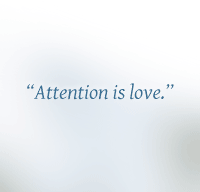Practicing Zen is zazen. For zazen a quiet place is suitable. Set aside all involvements and let the myriad things rest. – Dogen Zenji, “Rules for Zazen”
To start, let go of the ideas you may have about what meditation is supposed to look like or what meditation is supposed to feel like. Let the monkey in your mind go to sleep so that you can wake up and reclaim your rightful home.
Unless you have a meditation cushion, or zafu, do not attempt to sit cross-legged on the floor to meditate. Without adequate support to elevate your buttocks and enable you to anchor your knees on the floor, sitting this way quickly becomes painful. The point of meditation is not pain. Your life is painful enough as it is. The point of meditation is to relieve pain.
What follows are instructions for meditating in a chair. Although you are unlikely to have the perfect chair in your home for meditation, any chair is perfectly okay. So do not delay your practice until your trip to the Furniture Mart.
1. Sit on the forward third of a chair so that your feet rest firmly on the ground. To support your back, place a hard cushion between your spine and the chair back. This will prevent slouching and keep you alert.
2. Space your feet widely apart. Your body is now supported at three points: your two feet and your bottom. In seated meditation, three contact points are essential for endurance and comfort. Your body now evokes the strength of a mountain.
3. Place your hands in the middle of your lap as follows: first, your right hand, palm up; then, your left hand, palm up, resting in your right palm. Lightly touch the tips of your thumbs together. Holding your hands in this way calms agitation and restlessness.
4. To check your posture, align your ears with your shoulders. Align your nose with your navel. Tuck your chin in slightly. Hold your head as though it were supporting the sky, and it will neither hang forward nor fall backward.
5. Relax your belly. A stiff, cinched abdomen restricts your breathing. In meditation, you will try to return to the full, rounded breathing of a baby. Watch a baby breathe and see that the belly rises on inhalation, not the chest. This is a good demonstration for you to learn from.
6. Lower your gaze, but do not close your eyes. If you close your eyes, you will be lulled into daydreaming. Meditation is not practice for sleeping; it is practice for waking up. Look at a spot on the floor or on a wall in front of you. Any spot will do, as long as it is not distracting.
7. Close your teeth and your mouth. Take a breath and exhale completely.
8. On your next inhalation, silently count “one.” When you exhale, silently count “two.” Inhale counting “three.” Count each exhalation and inhalation up to “ten” and then start back at “one.” If you lose the count, begin again at “one.” This meditation practice is called counting your breath.
9. When a thought comes up, let it go away by itself, which it will if you do not pursue it.
10. This is the practice of zazen. Do zazen for up to five minutes. Keep a watch or clock nearby to note the time. As you meditate more often, you may be able to do it for longer. Do not be self-critical or impatient with yourself. Do not push yourself. Do not make meditation one more thing you have to do. If you are gentle, encouraging and consistent with yourself, your meditation practice will naturally deepen and lengthen.
Five minutes is not a long time, but it can take a long time to find five minutes to meditate. Usually, the first five minutes or the last five minutes in the day are the easiest to find. You already have them and they are already quiet.
I will be most happy to answer your questions and encourage you to keep going.




Karen,
what are your thoughts on lying down?
I have practiced both sitting and lying and somehow find I have an easier time lying down. I picked this up from the ease I had in a yoga class.
Comment by underthebigbluesky — July 12, 2009 @ 2:51 am
Savasana, or corpse pose, is sometimes called meditation in a yoga class. But it is perilously close to falling asleep, while sitting up is about staying awake. Either way, try it with your eyes open.
There are many, many ways to practice relaxation. Seated meditation is the way to practice attention.
Comment by Karen Maezen Miller — July 12, 2009 @ 3:00 am
This last year, my sitting practice has been sporadic, at best, but just the last three days, I have been sitting for 15 minutes in the morning.
These minutes aren't quiet — in fact, I leave the door open so I can hear my two kids as they play (I am the only one home then). But my practice is actually hearing them, noticing my tension when their voices raise, and bringing myself back to the cushion. Their squabbles have not risen to a fever pitch, and I have not needed to leave the cushion to attend to them (yet). For now, I stay put, and attend to them, and to me, right where I am.
I am so grateful.
Comment by Stacy (mama-om) — July 12, 2009 @ 8:53 pm
This comes to me at a perfect time. I've been wanting to try to meditate, having read similar instructions in your book, but haven't yet, mainly because I forget. But with my partner out of the country and my mind unquiet, I will try this tonight. Thank you! (And I like Mama-om's idea to do this with the kids' sounds in the background. Those sounds are always with me during the day and I think it would be curious to practice that way. But first, a few times alone, at night, in the quiet).
Comment by J — July 12, 2009 @ 11:35 pm
Wonderful. Just so you know, the quiet I speak of has nothing to do with sounds. It is the quiet of the mind. A quiet mind remains quiet regardless of the sounds that come and go. But people, especially at the beginning, may be distracted by external sound, and so I offer those times to prove that even a noisy life has quiet.
At the center where I do retreats, we hear the constant sounds of the inner city: traffic, street noise, people talking and yelling, an ice cream truck. Believe me when I say that these sounds come in waves like the ocean, and are no more disturbing to one's practice.
Comment by Karen Maezen Miller — July 13, 2009 @ 12:23 am
This is a great blog. I found it by following a comment you left at The Second Road. Adding you to my Google Reader.
I worked at Omega for several years, and loved meditation–it was easy there. We had a sanctuary and lots of zafus or backjacks. The challenge is making space within my home for meditation.
Great info!
Comment by Speak YOUR Peace — July 13, 2009 @ 2:13 pm
Hi Karen,
I, too, have recently added your blog to my google reader. I appreciate your simple approach to meditation. It all helps, especially tossing out any notions of what meditation should look like. My primary form of meditation is metta. In fact, I posted on it on my blog today. That, and just a simple breath practice, much like what you offer here.
I've enjoyed your writing for quite a while now and send you blessings for many more years of soulful writing. Be well…
Comment by Jan — July 13, 2009 @ 3:49 pm
Jan,
Rest assured our meditations are the same. Without thought, breath itself is metta, and we are each manifestations of its source.
Comment by Karen Maezen Miller — July 13, 2009 @ 5:12 pm
I appreciate the point that a thought will go away on its own if you don't follow it.
Comment by Mary Ann — July 14, 2009 @ 3:42 am
Like bubbles rising in a glass. They simply reach the surface and disappear. Few of us realize how wholly devoted we are to developing the drama, the schemes, the three-act plays in our head.
Comment by Karen Maezen Miller — July 14, 2009 @ 3:50 am
I've been looking for an excuse to start meditating again and here I am!
Comment by The Other Laura — July 14, 2009 @ 1:43 pm
This is a wonderful lesson in sitting. I read it during the Unitarian Universalist church service I did on zen. Then we all sat for 5 minutes. Several UU members were so grateful for this little treat into quietness. Thanks for this gift.
I love the blog too. I tweeted about it.
Comment by erinnburch — July 18, 2009 @ 3:03 am
[…] to make a decision and you’re not quite certain that you know what to do, try this: 1. Follow Karen Maezen Miller’s recipe for zazen meditation. 2. Invite your intuitive mind-body to help you with your challenge. I find it helpful to say to […]
Pingback by Learning from a Beginner | LaurenBacon.com — June 25, 2012 @ 11:17 am
[…] ground & centre yourself – whatever that looks like for you. I like Karen Maezen Miller’s incredibly simple approach. (Sidebar: I recommend her book, Momma Zen: Walking the Crooked Path of Motherhood, to anyone […]
Pingback by Master Your To-Do List, With the Flip of a Coin | Curious for a Living — September 27, 2012 @ 8:34 am
[…] of meditation. You can google “How to Meditate” and get an overwhelming amount of info. Karen Maezen Miller offers her own instructions on Zazen meditation. There is also Kundalini meditation, Transcendental Meditation, Guided Visualization, Qi gong…and […]
Pingback by DIY. | unchartedground — December 6, 2014 @ 8:50 pm
Hi, thanks for sharing this explanation. I would be grateful if you could comment on why meditation guidance seems to favour breathing through the nose over breathing through the mouth. thanks!
Comment by Andrew — April 18, 2018 @ 1:10 pm
I’ve never asked, nor have I been told, but I would say because it is natural. Everything about meditation is natural, it’s just that when it comes to being natural we are out of practice.
Comment by Karen Maezen Miller — April 18, 2018 @ 3:14 pm